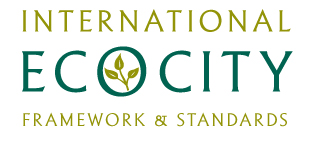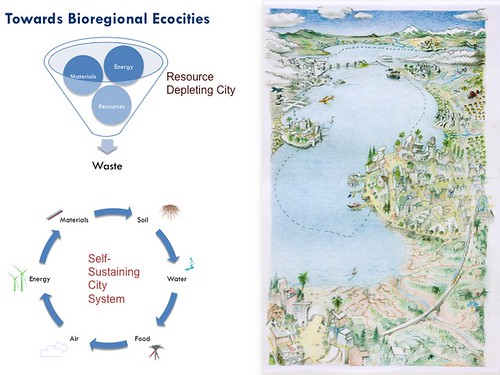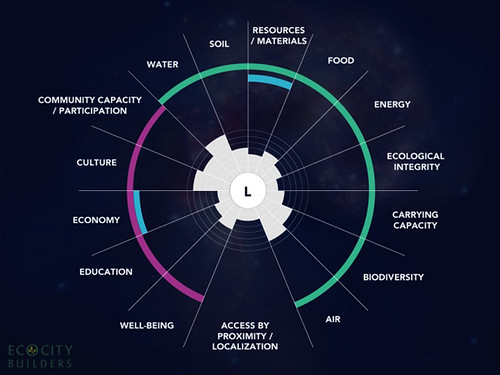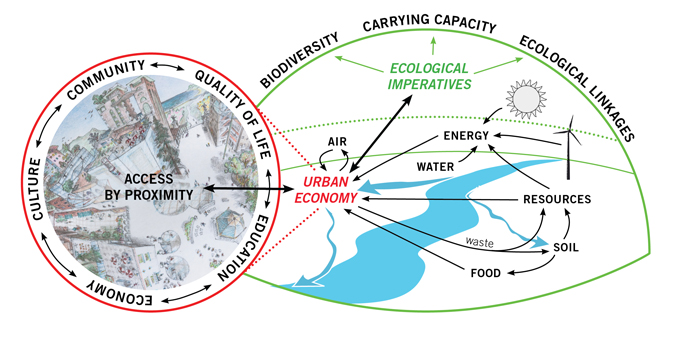After largely ignoring the role of cities and local governments at its first 15 climate conferences, the United Nations Framework Convention on Climate Change (UNFCCC) took a huge step at COP16 in Cancun when the Subsidiary Body for Implementation (SBI) for the first time in history officially adopted local governments as “governmental stakeholders”. What this means in plain English is that the work being done in cities, towns, villages and communities around the world to lower our carbon footprint will from now on have a direct impact on the highest levels of decision and policy making in the UNFCCC.
Sounds somewhat trivial, unsexy and anticlima(c)tic, but a quick look at the UN’s own Global Report on Human Settlements 2011 – Cities and Climate Change as summarized by BBC news (UN report: Cities ignore climate change at their peril) shows why this was such a significant breakthrough:

- Urban areas are set to become the battleground in the global effort to curb climate change, the UN has warned.
- The assessment by UN-Habitat said that the world’s cities were responsible for about 70% of emissions, yet only occupied 2% of the planet’s land cover.
- While cities were energy intensive, the study also said that effective urban planning could deliver huge savings.
- The authors warned of a “deadly collision between climate change and urbanisation” if no action was taken.
The conversation about a Local Government Climate Roadmap process continues this Friday through Sunday at COP17 in Durban with the Durban Local Government Convention: adapting to a changing climate – towards COP17/ CMP7 to build on the outcomes of the Resilient Cities 2011 congress, which focused on “understanding and improving the profile of adaptation as a critical tool in achieving local developmental and sustainability objectives.”
What this means is that there’s going to be more talk about the role of cities at COP17, though it’s not exactly the kind of stuff that gets bodies moving and booties shaking.
But I betcha this will…
———————||
———————||
———————||
———————√
Really, this is not just gratuitous fun and excitement. The show is indeed going to be descending upon the carnival capital.
The Road to Rio…
That’s right, the delicate dance toward meaningful economic and environmental action will continue June 20-22, 2012 at The United Nations Conference on Sustainable Development (UNCSD). Also known as Rio+20, its themes of Green economy in the context of sustainable development and poverty eradication and Institutional framework for sustainable development position it at the intersection of society, economy and the environment, smack dab in the middle of cities, towns and villages, their citizens, their economies and the rural areas and ecosystems that sustain our human civilization.
Rio+20 is going to be a great opportunity to not only talk about the importance of cities and local governments in regard to sustainable development, but to introduce an effective international framework as well as a practical methodology for assessing and guiding progress towards the goal of an ecologically-restorative human civilization.
A LEED Ratings System for cities, if you will.
The International Ecocity Framework and Standards (IEFS)

The International Ecocity Framework and Standards (IEFS) initiative seeks to provide an innovative vision for an ecologically-restorative human civilization as well as a practical methodology for assessing and guiding progress towards the goal.

Full disclosure: I’ve been involved with the IEFS initiative, developed by UN-accredited nonprofit Ecocity Builders, in various capacities.
What is an Ecocity?
One of the big problems with words like “Green” or “sustainable” or “environmental” is that there aren’t really any clear definitions of what they mean at any given time and place, or within different contexts, and thus they can become watered down clichés, less than helpful in any kind of objective evaluation. For example, the word “ecocity,” these days frequently used for any city with a bike lane or recycling program, was coined by Richard Register with a very specific definition in mind:
An Ecocity is a human settlement modeled on the self-sustaining resilient structure and function of natural ecosystems.
- An ecocity seeks to provide healthy abundance to its inhabitants without consuming more renewable resources than it replaces in its bioregion.
- It seeks to function without producing more waste than it can assimilate or recycle for new uses or than nature can dilute and absorb harmlessly, and without being toxic to itself or neighboring ecosystems.
- Its inhabitants’ ecological impacts reflect planetary supportive lifestyles; its social order reflects fundamental principles of fairness, justice, reasonable equity and consensus at ample levels of happiness.

However, in order to apply any concept to a broad, living, breathing human environment, a simple definition does not suffice. Creating a metric by which a diverse range of participants can measure progress toward a broader definition requires a holistic and multi-dimensional approach.
In the context of the LEED Ratings System, for example, the benefits of a solar-powered office building may be offset by its location requiring employees to commute by car, or the use of recycled materials may be offset by poor insulation. In fact, as LEED itself has fallen short of addressing broader bioregional or climate-specific factors, more advanced measurements like The Living Building Challenge, an advocacy tool and certification program that can be applied to development at all scales, from buildings to infrastructure, landscapes and neighborhoods, have been developed.
When taken into an even larger context such as entire cities and urban systems, it’s clear that the framework upon which the measurement is based must consist of a whole systems approach that takes into consideration a multitude of bioregional, sociocultural, ecological, and urban design indicators and conditions, and the The International Ecocity Framework and Standards does just that.
IEFS Conditions
Here’s a way to visualize an ecocity assessment along 15 conditions/dimensions (coded for natural capital, social capital and financial capital).

You can find more details about each condition here, but by looking at the graphic you realize that a healthy ecocity is an interconnected organism depending as much on full community participation and an equitable economy as on clean air and close proximity.
The goal of the IEFS is to provide support and criteria by which cities on a global scale can adopt measures that would enable them to meet as many of these conditions as possible and successfully move toward becoming ecocities. Participating cities will be able to assess their ecological condition in conjunction with a global network of local governments and subject matter experts committed to a whole-systems improvement process.

It’s clear that any kind of meaningful action on reducing carbon emissions and restoring a balanced ecosystem leads through the world’s cities and local governments, and it’s great to see this addressed at the climate conferences in Cancun and now Durban. It’s also clear that talk alone won’t get us there and that we can’t rely on the major players to make things happen.
That’s why the IEFS is such a promising and exciting initiative that, if adopted into a UN framework at Rio+20, would contribute tremendously toward transforming the current top-down trajectory of climate negotiations into a bottom-up process. Cities and citizens would be enabled to maximize resilience through a whole systems approach that responds to critical risk factors for climate change and natural disasters while concurrently working with a network of cities around the world taking action to restore planetary boundaries to safe and stable conditions.
And that, folks, is pretty HOT STUFF!
o~O~o~O~o~O~o~O~o~O~o~O~o~O~o~O~o~O~o
Originally posted as part of the Durban Daily series on Daily Kos
“Space required to transport 60 people” poster by the City of Münster, Germany










[…] as easy as just walking up to Ban Ki-moon and saying “yo bro, let’s get this ecocity standards thing going.” Instead, the UN is more like a labyrinth with all the exits blocked, […]
[…] as easy as just walking up to Ban Ki-moon and saying “yo bro, let’s get this ecocity standards thing going.” Instead, the UN is more like a labyrinth with all the exits blocked, […]
[…] as easy as just walking up to Ban Ki-moon and saying “yo bro, let’s get this ecocity standards thing going.” Instead, the UN is more like a labyrinth with all the exits blocked, […]